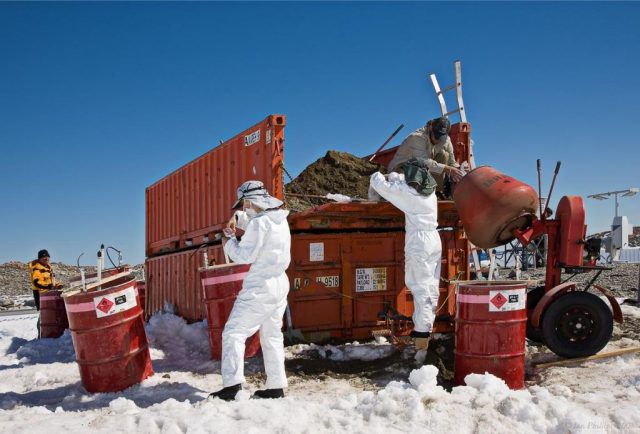Cleaning Antarctica: Is the cure worse than the disease?
The Unknown Continent, the White Desert. In the past only few -and brave- people, such as Shackleton, Amundsen or Scott, dared to explore Antarctica. Nevertheless, in the fifties scientists started thinking that it was a very interesting place for doing research, due to its unique conditions, and started building more and more stations. By that time there were already several territorial claims in Antarctica and the Cold War was underway so, maybe to prevent a deterioration of the situation, the twelve countries that were active in Antarctica during the International Geophysical Year of 1957-58 signed the Antarctic Treaty in 1959.
This document states beautiful things like “Antarctica shall be used for peaceful purposes only” and “scientific observations and results from Antarctica shall be exchanged and made freely available”1, but the environmental and ecological management of the continent was not very well described. To solve that, the Antarctic Treaty was upgraded in 1991 by the approval of the Protocol on Environmental Protection. The following paragraph is an extract of the section about the wastes, very important for the article we are going to discuss:
Past and present waste disposal sites on land and abandoned work sites of Antarctic activities shall be cleaned up by the generator of such wastes and the user of such sites. This obligation shall not be interpreted as requiring:
(a) the removal of any structure designated as a historic site or monument; or
(b) the removal of any structure or waste material in circumstances where the removal by any practical option would result in greater adverse environmental impact than leaving the structure or waste material in its existing location2.
It truly sounds sensible. But since the Protocol was approved there have been no published reports of studies testing if the removal of the sites was being achieved with or without creating further environmental impacts. At least not until Jonathan Stark and his group monitored the cleanup of Thala Valley Waste Disposal Site, at the Australian Casey Station, located in East Antarctica3

Thala Valley Waste Disposal Site operated between 1965 and 1986. During those years some of the wastes were dumped and burned, and others were just disposed of in holes in the sea ice. Wastes like ash, gravel, vehicle parts, glass, plastics, batteries, asbestos and oils. Considering that the site is hidrologically active and when the ice melted in the summer the water would flow into Brown Bay, carrying the pollutants, the existence of several studies describing the adverse impacts this site was causing in the adjacent marine environment it is not surprising. That and other concerns, like the scattering of the rubbish over the surrounding region due to the strong wind, the presence of wildlife exposed to contaminants and the visual impact of the wastes, made the Australian Antarctic Division target the cleanup of the station as a priority.

The authors of this article accomplished a sediment field mesocosm experiment to monitorize this cleanup and analyze its possible consequences. Also, they tested and develop different techniques to help future similar operations in Antarctica.
Wikipedia defines mesocosm as “an experimental tool that brings a small part of the natural environment under controlled conditions”. This kind of experiment allows focusing on the variables of interest in heterogeneous surroundings. In the case at hand, Brown Bay was already polluted so Stark and his group used clean, standard, defaunated sediments to make sure that the communities recolonising those sediments would only be affected by the ongoing or new disturbances and not by past impacts. The clean sediments were collected from an uncontaminated area and deployed at four locations, two adjacent to the disposal site in Brown Bay and two at control sites. The collection period covered from one year before the cleanup to about two years after its finalization, and they analyzed metals, total organic matter and macrofaunal communities.

On the whole, they conclude that although some contaminated material was released during the cleanup operation, the remediation operation did not create greater adverse environmental impact on the already impacted Brown Bay. This time, then, the cure was better than the disease. Thus, the authors hope these results will encourage others to perform future cleanup initiatives in Antarctica.
References
- Secretariat of the Antarctic Treaty ↩
- Annex III to the Protocol on Environmental Protection to the Antarctic Treaty. Waste disposal and waste management. Article 1.5 ↩
- Stark J.S. & Martin J. Riddle (2014). A sediment mesocosm experiment to determine if the remediation of a shoreline waste disposal site in Antarctica caused further environmental impacts, Marine Pollution Bulletin, 89 (1-2) 284-295. DOI: http://dx.doi.org/10.1016/j.marpolbul.2014.09.045 ↩